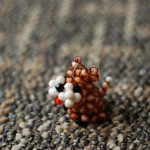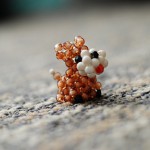- Beaded Dog 1
- Beaded Dog 2
- Beaded Dog 3
Q: “How do you make these objects?”
A: “You first take some string and some beads, and by stringing the beads together and making little circles by looping the string through the beads. You can manipulate the string and the beads to make all kinds of shapes and cute figures. We make a lot of little animals.”
Q: “With whom do you normally make the beaded animals?”
A: “Usually in groups of friends, but you can do it by yourself, too.”
Q: “Who taught you how to bead?”
A: “Chinese school offered classes where the teacher showed us how to make different things.”
Q: “How did she teach you?”
A: “She made the beaded figures with us, and gave us handwritten instructions that she had learned from her friends or teachers in the past.”
Q: “Why do you make these animals?”
A: “It’s fun, and usually it’s when I get to talk with other friends when we bead together.”
Q: “Do they hold any significant value to you?”
A: “I like them because I made them, and I can use them as key chains to remember my friends. I taught my daughter how to make them, too, and sometimes she gives me the figures she makes. I like to carry those ones around the most.”
My informant, though at first a little hesitant to offer up information on this type of folklore, brings up an important point—though the objects do not hold a cultural significance, they do hold a personal kind of significance for each person. She really appreciates beading these figures because of the time she is able to spend with her friends and daughter. The physical object, though close to worthless being that it is only plastic beads and plastic string, obtains a sort of pricelessness because of the memories it recalls in my informant when she carries them around with her—she thinks of her friends and her family. The beaded objects are not valued for anything other than their looks and resemblance of the real life objects which they mimic, but the active participation in the object’s creation is what makes a plastic object valuable.



